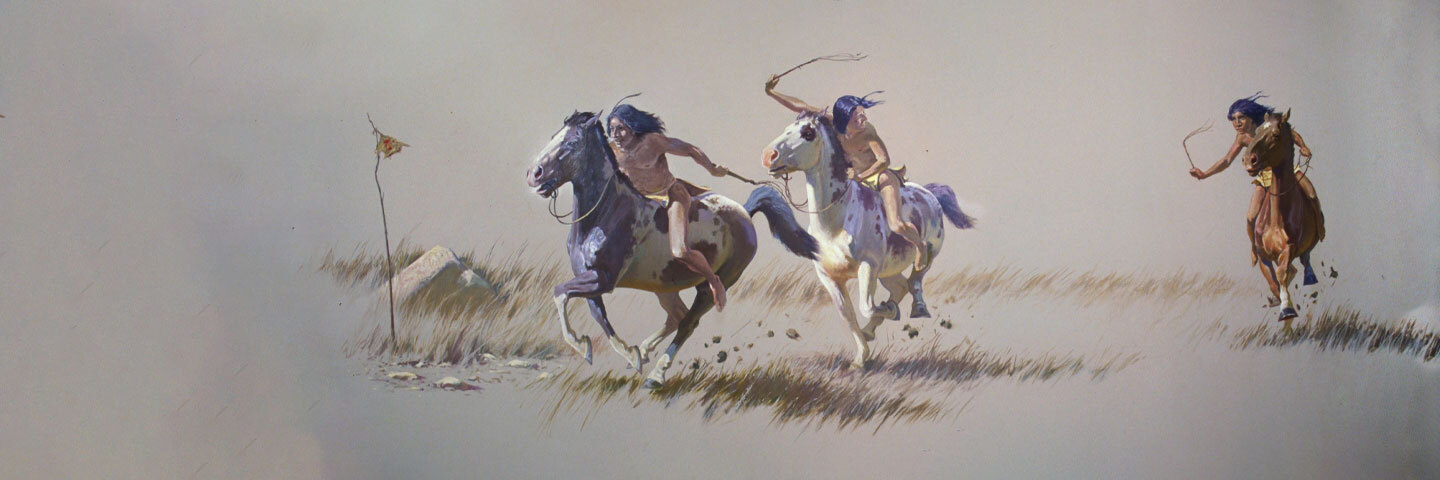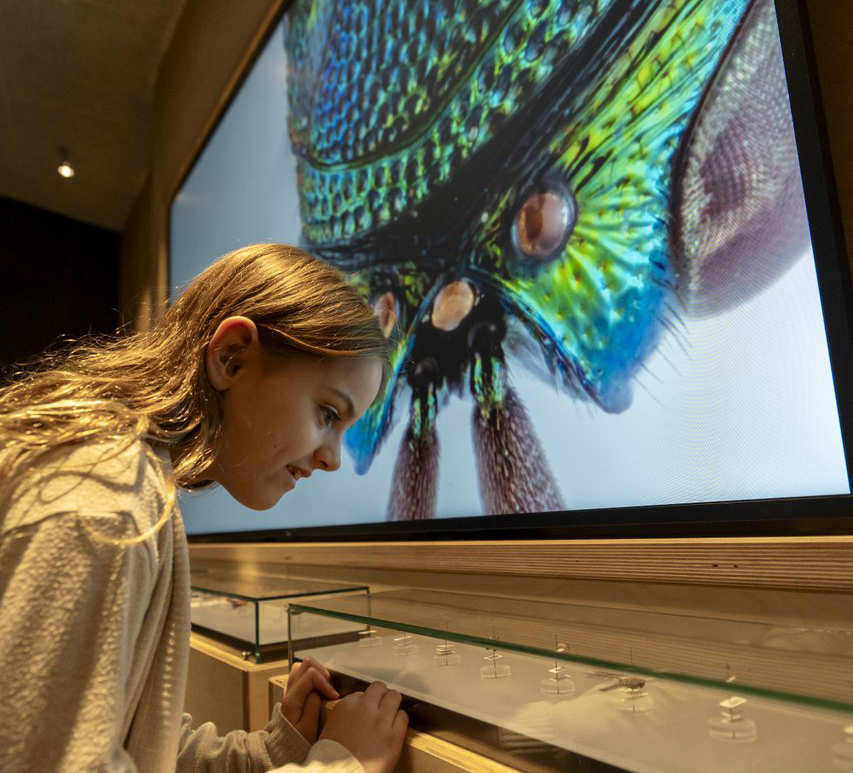Tansi kwak keeyo. Welcome.
This gallery offers a dramatic view of the history and traditions of Indigenous societies that live in Saskatchewan. See First Nations artwork and learn about their relationship with the land over the past 10,000 years.

Wi-sa-ke-cahk
The sculpture incorporates characters and elements from the many different versions of the Wi sa ke cahk and the Creation of Turtle Island story. The Trickster is a principal character in many Indigenous stories. He is known as Wi sa ke cahk to the Cree, Nanabush to the Saulteaux, Inktome to the Dakota and Nakota, and Sagija'k to the Dene.
Tipis
We don't know for certain, but some stone circles that once held down the edges of tipis are as old as 6,000 years. Tipis provided a comfortable and portable home year-round. In the summer, people camped on the open plains to hunt bison and collect plants. At designated times, as many as 200 families would gather together for ceremonies or large communal bison hunts. In the winter, people moved into valleys or wooded areas where they were sheltered from the wind and had lots of firewood.
The tipi is the quintessential symbol of Indigenous peoples who live on the plains. But did you know that each part of the tipi symbolizes a moral principle? These principles, such as respect, humility, faith, and sharing, that must be followed if the family and society are to live together in harmony.
Community
A community is made up of many different members. For Indigenous peoples, Earth as community is made up of many different beings that include rock, plants, animals, and humans. Humans are a part of that community; they are not above it or outside it.

Working Together
Through these works of art, people express who they are as individuals and as a community.
All members of the family -- grandparents, parents, aunts and uncles, brothers and sisters, sons and daughters -- had to work together in order for the family and the community to survive. Each person had his or her own tasks to do. All were respected for their work and for their talents. Today, new professions and new workplaces have been added to the old ways. Even so, people still observe the traditional values of working together and respecting people for their work.
A person is known and respected for generosity and service to others. Elders are respected for their age and the wisdom they have acquired on their journey through life. Leaders are respected because they have learned to balance greatness with humility.
Horned headdresses are worn by highly respected men. The horns are symbols of strength and, as such, bring protection and good fortune to the wearer.
Time Well Spent
Some stories can be told at any time of the year, but most stories are reserved for telling during winter. There is even a story about why stories are told during the winter.
Modern powwow dancing is derived from ancient traditional dances. Men danced upon returning from the hunt or from war to announce and display their achievements. Women danced around the edge of the dance circle to symbolize their special connection with the life cycle of Earth itself.
Today's powwow dancers dance for many reasons: to express their identity as Indigenous peoples; to show their gratitude for life and its blessings; to lift the spirits of those who watch; and to touch part of their history and heritage.
Yearly Circle
Throughout the year many kinds of berries and other plants could be found in different locations, along with the animals that fed on them. People that followed this cycle of food gathering were participating a "seasonal round" of nomadic camping across different landscapes.

Summer: Bison Hunting
Bison provided the Indigenous peoples of the plains with most of their food, clothing, shelter, and tools. As a result, bison played a central role in their ceremonies and beliefs.
A pound or trap was one way of killing large numbers of bison. People built a corral of logs and hides at the foot of a steep slope. After the appropriate ceremonies, runners were sent out to lure the herd toward the pound. As the bison approached the entrance, people yelled and waved robes to stampede the herd into the pound.
The hard work began after the kill. Hides were stripped off the carcasses and fleshed and dried. Meat was smoked or air-dried. Bones were made into tools, or crushed and boiled to remove bone grease. Horns and hooves were boiled into glue. Hair was twisted and braided into rope. Numerous internal organs were transformed into containers.
Fall: Caribou Hunting
The hair of the Caribou is hollow, making it an excellent insulating material to make winter clothing.
In the past, Dene trapped caribou with fences and pounds, snares, and pitfalls in snowbanks; they also intercepted them at river crossings. Today, the Dene use snowmobiles and rifles.
Because caribou are central to their life and identity, Dene work with the governments of Saskatchewan, Manitoba, and the Northwest Territories to ensure that the caribou survive.

Winter: Moose Hunting
Today, rifles are essential tools. During the rutting season, hunters will imitate the call of female moose to attract a bull moose within shooting range.
Hunting is still important because wild meat is more economical than store-bought food. People also prefer the taste of wild meat. Traditional hunters still pray and make offerings to acknowledge the sacrifice made by the moose so that their families will have food to eat.
Spring: Fishing
They constructed weirs or traps at narrows in rivers and streams.
The arms of the weir consisted of two converging barriers of logs or stones which forced the fish toward a narrow opening and into nets, baskets, or traps.
If the fish were to be eaten immediately, they were split and roasted over a fire, or were filleted and boiled. If they were to be preserved, they were split and hung over fires to smoke dry.
We Are All Treaty People
See the living and breathing promises of Treaty 4 from a unique view point -- that of the Indigenous peoples who signed the original document.

Indigenous Perspective
Today, united by the agreements made in Treaty 4, we are all Treaty people. In this exhibit, see Treaty 4 presented in a rare document: Canada's only known written record of Treaty promises from the viewpoint of Indigenous people.
Trades, Treaties and Today
The treaties signed in Saskatchewan during the late 1800s and early 1900s were a response by both Indigenous peoples and the federal government to significant changes taking place in western Canada.

Changing World
Indigenous peoples were concerned about the dramatic decrease in bison herds, about the effects of disease, and about the impact of agricultural settlement on their ability to continue their traditional lifestyle.
For the Crown, treaties would legitimize government control of the land. For Indigenous peoples, treaties would protect their lifestyle and provide assistance to meet the changing world.
In 1869, the Canadian government purchased Rupert's Land from the Hudson's Bay Company and began to survey the land to sell it to homesteaders. The government believed that Indigenous peoples would soon disappear because of disease and starvation.
Indigenous peoples did not understand how anyone could "own" land. They believed that resources were to be shared by all, and they were more than willing to assist incoming settlers. However, they also wanted to ensure the survival of their people and their cultures in the face of this changing world.
Treaty agreements were not always fulfilled. Some reserve lands were never allotted; in other cases, Indigenous peoples were pressured to surrender reserve land. Food and medical assistance were not always forthcoming. Agricultural training was not always supported with enough seed and equipment to make farming a success. Government controls were burdensome and often provided too little assistance too late.
In 1876, Treaty Indians came under the jurisdiction of the Indian Act. This made them wards of the Crown and "non-persons" before the law. All decisions were made by local Indian agents and by politicians and bureaucrats in Ottawa. In 1951, the Indian Act was revised to recognize Indigenous peoples as legal "persons" and to give them rights enjoyed by other Canadian citizens, such as the right to vote.



